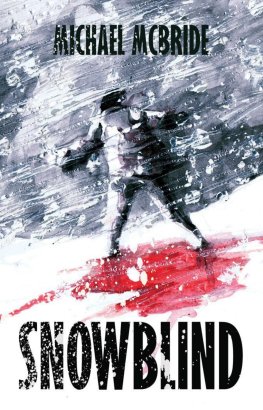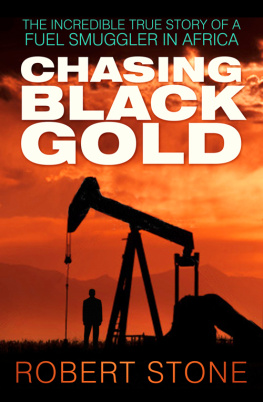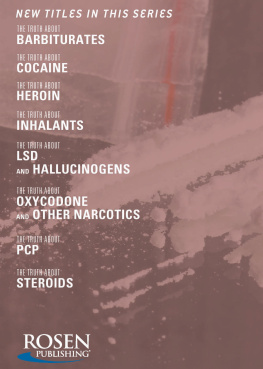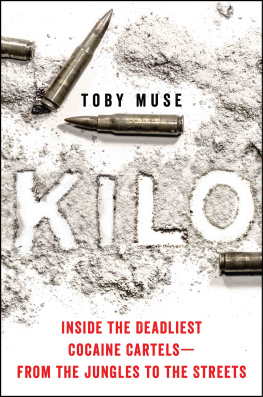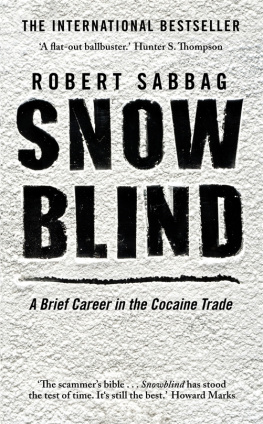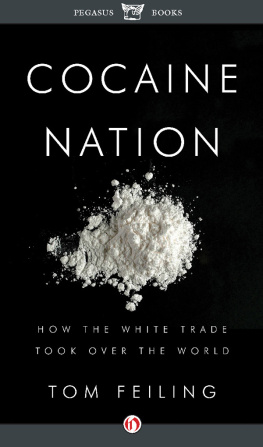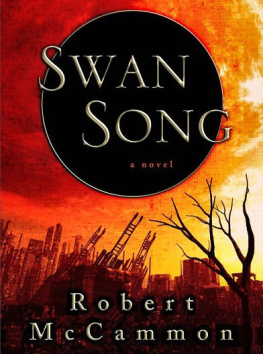Praise for Snowblind:
An extremely rare cut of dry wit, poetry, rock-hard fact and relentless insight.
Rolling Stone
Fascinating.
Houston Chronicle
Alternately scary and funny, wherein an incident or an insight is compressed and polished to an impressive sheen.
The Baltimore Sun
One of the most dazzling and spectacular pieces of reporting I have ever read.
Nora Ephron
A classic.
The National Review
Hip and often very funny ... provocative ... and utterly convincing.
The Miami Herald
After reading Robert Sabbags Snowblind, one is overcome with a sense of having finally understood America. It is that rare kind of book that compels a reader to call up all of his friends and read passages to them over the telephone. It is destined to become an American classic.
Claude Brown, Jr.
Its excellent ... characters leaping to life right out of Ernest Hemingway and Damon Runyon, and everywhere, supercharging, that fine electric dust of Cordilleran snow. I hate to think of what Sabbag must have gone through to write it.
Richard Rhodes
The style is charged with energy.
The Boston Phoenix
This is a glorious and glittering piece of craftsmanship like good surgical steel ... an exciting, living storybeautifully told, addictively readable, and as urgent as a siren coming to a sinister stop in front of where we all live.
Davis Grubb
The most authentic insider story of the big-time cocaine trade that has hit print, and Sabbag tells it with novelistic razzle-dazzle, setting down knife-sharp scenes as the action moves: Mexico, New Yorks big hotels, Harlem streets, Bogotaa high and low-life ... scenes and characters that make your skin crawl. A compelling read.
Publishers Weekly
A beautifully written book.
Rita Mae Brown
Robert Sabbag is one beautiful writer.
Nashville Banner
SNOWBLIND
Also by Robert Sabbag
Smokescreen
SNOWBLIND
a brief career in the cocaine trade
ROBERT SABBAG

Copyright 1976, 1990 by Robert Sabbag
Afterword copyright 2010 by Robert Sabbag
All rights reserved. No part of this book may be reproduced in any form or by any electronic or mechanical means, including information storage and retrieval systems, without permission in writing from the publisher, except by a reviewer, who may quote brief passages in a review. Scanning, uploading, and electronic distribution of this book or the facilitation of such without the permission of the publisher is prohibited. Please purchase only authorized electronic editions, and do not participate in or encourage electronic piracy of copyrighted materials. Your support of the authors rights is appreciated. Any member of educational institutions wishing to photocopy part or all of the work for classroom use, or anthology, should send inquiries to Grove/Atlantic, Inc., 841 Broadway, New York, NY 10003 or permissions@groveatlantic.com.
First published in the United States in 1976 by the Bobbs-Merrill Company, Inc.
Published simultaneously in Canada
Printed in the United States of America
Library of Congress Cataloging-in-Publication Data Sabbag, Robert.
Snowblind: a brief career in the cocaine trade / Robert Sabbag.
p. cm.
Originally pubished: Indianapolis: Bobbs Merrill, c1976.
Includes index.
ISBN 0-8021-9756-8 (e-book)
1. Cocaine habit. 2. Narcotics, Control ofUnited States.
3. Cocaine industryUnited States. I. Title.
HV5810.S23 1998
364.177dc21
98-28083
Grove Press
an imprint of Grove/Atlantic, Inc.
841 Broadway
New York, NY 10003
Distributed by Publishers Group West
www.groveatlantic.com
For Thomas J. Butler
Forsan et haec olim meminisse iuvabit ...
BREAKAWAY
1
INDIAN SUMMER
Zachary Swan is not a superstitious man, but he is a very careful one. Like any professional gambler, he has survived by taking only calculated risks. So, in October of 1972, when he decided to throw a party to celebrate his most recent return to New York, he decided to throw a small one, and his caution was inspired less by the fact that it was Friday the thirteenth than by the compelling reality that on the mantelpiece above his suitcase there were three and a half kilograms of 89-percent-pure cocaine.
The cocaine had entered the United States that morning in the hollows of three Colombian souvenirs fashioned out of Madeira wood. They included a long, colorfully painted rolling pin, the symbol of marital bliss in Colombia; one rough-hewn statue, twenty inches high, of the Blessed Virgin; and a hand-wrought effigy of an obscure tribal head, about the size of a coconut. The fill had been made a week earlier in Bogot. The load had passed U.S. Customs at Kennedy Airport, New York. It was carried through and declared: Souvenirs.
The arrival of these artifacts at Zachary Swans beach house in East Hampton, Long Island, launched a celebration which would not end until the following morning. It began at eight p.m. when the Madeira head was cleaved top-dead-center across the parietal lobe with the cold end of a chisel. Within minutes of this exotic lobotomy a procedure reminiscent in equal measure of desperation combat surgery and a second-rate burglary attempt the skull yielded up 500 grams of high-grade uncut cocaine, double-wrapped in clear plastic.
By the time the skull, which looked like that of a shrapnel victim, was reduced to ashes around the andirons of the fireplace, the celebration had assumed ceremony and the coke was performing fabulous and outlawed miracles in the heads for which it had been ultimately intended. They belonged to Swan himself; his girlfriend Alice Haskell, twenty-four, a childrens fashion designer; Charles Kendricks, thirty, an Australian national and sometime employee of Swan; and Kendrickss girlfriend Lillian Giles, twenty-three, also an Australian. The Bolivian brain food they had ingested was only one course in a sublime international feast which featured French wine, English gin, Lebanese hashish, Colombian cannabis, and a popular American synthetic known pharmacologically as methaqualone.
It is difficult to verify at exactly what point in the proceedings (possibly over dessert) Swans originally calculated risk became a long shot. The party went out of control somewhere in the early hours before dawn, and the steps he had taken in the beginning to minimize his losses were eventually undermined by the immutable laws of chemistry his mind, simply, had turned to soup. He was up against the law of averages with a head full of coke. The smart money pulled out, and the odds mounted steadily. By sunrise, Swan was beaten by the spread.
Amagansett, New York, is situated 120 miles due east of Manhattan on the coastal underbelly of Long Island. One of several oceanfront resorts on the fringes of Long Islands potato belt, it owes its maritime climate to the temperate waters in the leeward drift of the Gulf Stream. The region was abandoned by Algonquins in the wake of colonial sprawl, a mounting overture to Manifest Destiny which brought New England to the outer reaches of the Empire State, and Amagansett, a tribute to the Indians in name only, is the custodian of a Puritan heritage. The whales are gone but the weathervanes remain. An occasional widows walk acknowledges the debt to the sea. Anchors and eagles abound. George Washington would have been proud to sleep here.
In the off-season, order prevails. Time struggles to stand still. But when the weather breaks and the trade winds come in, the elders of Amagansett, like their colonial predecessors and the Algonquins before them, find themselves volunteers in a counterassault on cultural blight minutemen knee-deep in the onslaught of souvenirs, fast-food and ersatz antiques. A kind of thug capitalism asserts itself. The tourists who come screeching down upon the town and the local retail sharks who surface to feed on them provoke an embarrassing display of provincial paranoia; and every summer, the town fathers, helpless, unhinged, watch their community move one irreversible step closer to the dark maw of the twentieth century, visibly shaken by what they consider to be a pronounced threat to Amagansetts Puritan soul.
Next page

